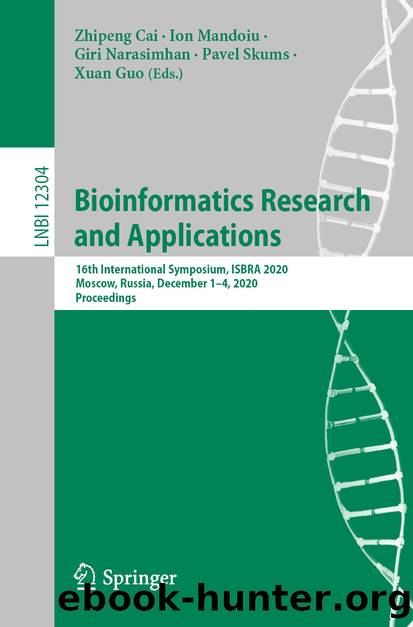Bioinformatics Research and Applications by Unknown

Author:Unknown
Language: eng
Format: epub
ISBN: 9783030578213
Publisher: Springer International Publishing
1 Introduction
The accurate inference of disease transmission networks is fundamental to understanding and containing the spread of infectious diseases [2, 10, 16]. A key challenge with inferring transmission networks, particularly those of rapidly evolving RNA and retroviruses [7], is that they exist in the host as “clouds” of closely related sequences. These variants are referred to as quasispecies [6, 22], and the resulting genetic diversity of the strains circulating within a host has important implications for efficiency of transmission, disease progression, drug/vaccine resistance, etc. The availability of quasispecies, or sequences from multiple strains per infected host, also has direct relevance for inferring transmission networks and has the potential to make such inference easier and far more accurate [18, 20, 23]. Yet, while the advent of next-generation sequencing technologies has revolutionized the study of quasispecies, most existing transmission network inference methods cannot use multiple distinct strain sequences per host.
Existing methods for inferring transmission networks can be classified into two categories: Those based on constructing and analyzing sequence similarity or relatedness graphs, and those based on constructing and analyzing phylogenetic trees for the infecting strains. Many methods based on sequence similarity or relatedness graph analysis exist and several recently developed methods in this category are also able to take into account multiple distinct strain sequences per host [9, 14, 19]. However, similarity/relatedness based methods can suffer from a lack of resolution and are often unable to infer transmission directions or complete transmission histories. Phylogeny-based methods [5, 11, 13, 16, 23] attempt to overcome these limitations by constructing and analyzing phylogenies of the infecting strains. We refer to these strain phylogenies as transmission phylogenies. These phylogeny-based methods infer transmission networks by computing a host assignment for each node of the transmission phylogeny, where this phylogeny is either first constructed independently or is co-estimated along with the host assignment. Leaves of the transmission phylogeny are labelled by the host from which they are sampled, and an ancestral host assignment is then inferred for each node/edge of the phylogeny. This ancestral host assignment defines the transmission network, where transmission is inferred along any edge connecting two nodes labeled with different hosts.
Several sophisticated phylogeny-based methods have been developed over the last few years. These include BEASTlier [11], SCOTTI [4], phybreak [13], TransPhylo [5], and phyloscanner [23], BadTrIP [3]. Among these, only SCOTTI [4], BadTrIP [3], and phyloscanner [23] can explicitly consider multiple strain sequences per host. BEASTlier also allows for the presence of multiple sequences per host, but requires that all sequences from the same host be clustered together on the phylogeny, a precondition that is often violated in practice. Among the methods that explicitly consider multiple strain sequences per host, SCOTTI, BadTrIP, and BEASTlier are model-based and highly computationally intensive, relying on the use of Markov Chain Monte Carlo (MCMC) algorithms for inference. These methods also require several difficult-to-estimate epidemiological parameters, such as infection times, and make several strong assumptions about pathogen evolution and the underlying transmission network. Thus, phyloscanner [23] is the only previous
Download
This site does not store any files on its server. We only index and link to content provided by other sites. Please contact the content providers to delete copyright contents if any and email us, we'll remove relevant links or contents immediately.
| Anatomy | Animals |
| Bacteriology | Biochemistry |
| Bioelectricity | Bioinformatics |
| Biology | Biophysics |
| Biotechnology | Botany |
| Ecology | Genetics |
| Paleontology | Plants |
| Taxonomic Classification | Zoology |
Sapiens: A Brief History of Humankind by Yuval Noah Harari(14305)
The Tidewater Tales by John Barth(12622)
Mastermind: How to Think Like Sherlock Holmes by Maria Konnikova(7270)
Do No Harm Stories of Life, Death and Brain Surgery by Henry Marsh(6902)
The Thirst by Nesbo Jo(6869)
Why We Sleep: Unlocking the Power of Sleep and Dreams by Matthew Walker(6646)
Life 3.0: Being Human in the Age of Artificial Intelligence by Tegmark Max(5501)
Sapiens by Yuval Noah Harari(5316)
The Longevity Diet by Valter Longo(5033)
The Body: A Guide for Occupants by Bill Bryson(5019)
The Rules Do Not Apply by Ariel Levy(4902)
The Immortal Life of Henrietta Lacks by Rebecca Skloot(4543)
Animal Frequency by Melissa Alvarez(4422)
Why We Sleep by Matthew Walker(4387)
The Hacking of the American Mind by Robert H. Lustig(4332)
Yoga Anatomy by Kaminoff Leslie(4327)
All Creatures Great and Small by James Herriot(4261)
Double Down (Diary of a Wimpy Kid Book 11) by Jeff Kinney(4237)
Embedded Programming with Modern C++ Cookbook by Igor Viarheichyk(4132)
